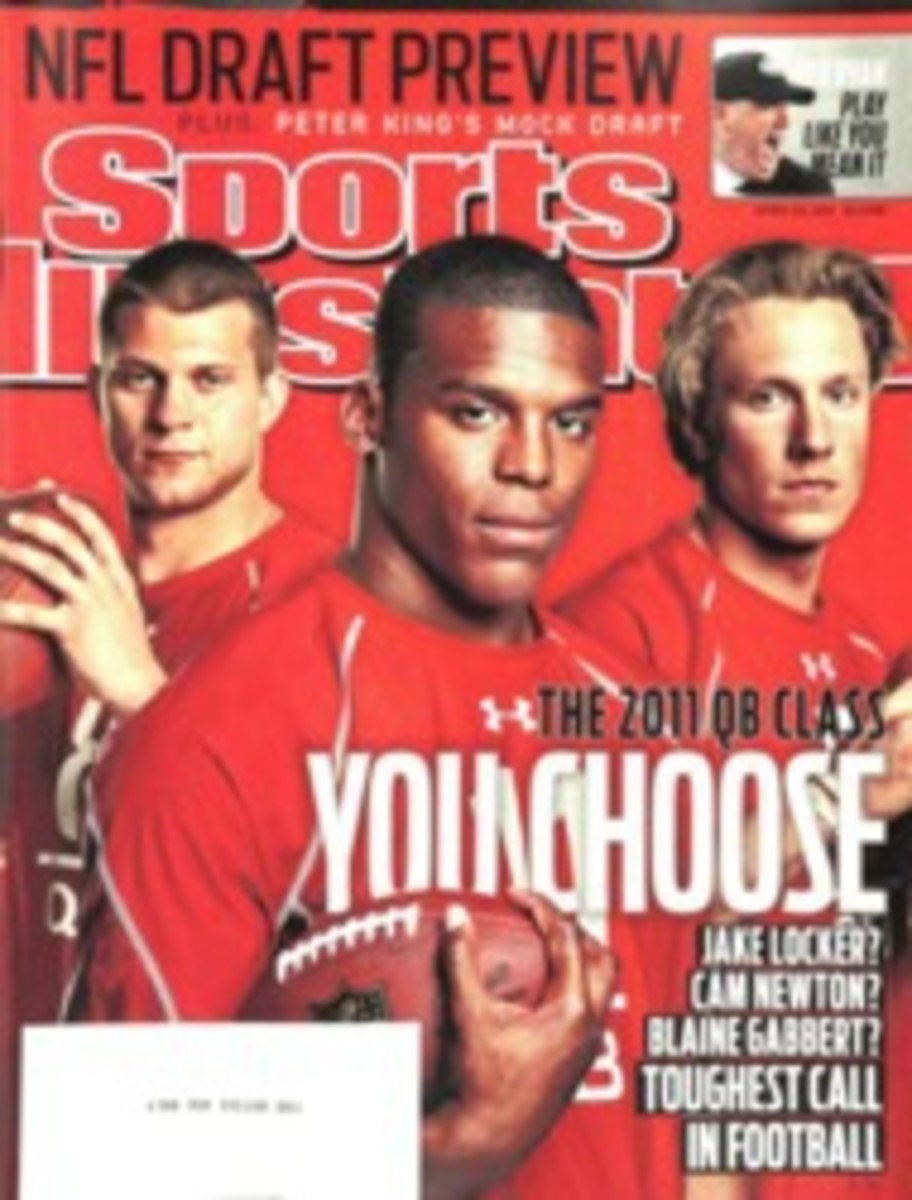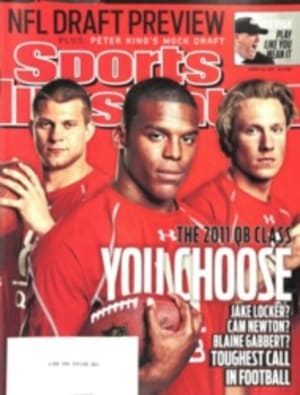
THE QUARTERBACK QUANDARY
In 1984 an engaging first-round quarterback prospect, Maryland's Boomer Esiason, was coming off a separated shoulder from a December bowl game. Cleared by doctors, he threw at the scouting combine in late January and then waited three months to be picked. Esiason visited no teams and had no Pro Day—in those days no schools did. One club, the Bengals, sent a coach to work him out. Cincinnati took Esiason midway through the second round.
In 2011 an engaging first-round quarterback prospect, TCU's Andy Dalton, is coming off a mostly healthy season and a terrific Rose Bowl. He threw at the combine and met with 21 NFL teams there; threw again at TCU's Pro Day, which was attended by 26 teams; worked out privately for 11 teams and visited six in March and April; ate meals with four quarterback coaches or coordinators; and faced at least one crazy job interview. A team will choose him no later than midway through the second round this year.
Esiason made it big. Dalton might. The inexact science of choosing a quarterback will be in the spotlight again at the 76th NFL draft next week, when as many as seven passers, all with professional or personal faults (or both), could be among the first 50 picks.
In a normal year some teams would solve their passing needs through free agency or trades, and veterans such as Donovan McNabb, Matt Hasselbeck, Marc Bulger and Kevin Kolb would have moved to new clubs by now. But because the labor stalemate prohibits trades or free-agent signings—and the league has banned under-the-table deals during the work stoppage—teams enter the draft without knowing whether they'll be able to snag one of those vets. So those needing a passer are probably going to be more aggressive. It's an ideal scenario for college QBs, and a potential recipe for disaster for the teams drafting them.
"They all have traits you love," says Jim Harbaugh, the rookie coach of the 49ers. "They all have traits you question. There's a lot of teams looking for the quarterback with the great NFL DNA."
Despite a decent streak in the last three drafts, NFL general managers haven't improved much in picking the most important player on the field. From 1980 to '95 (16 drafts), teams selected 35 first-round passers. Nine, from John Elway to Kerry Collins, became consistent long-term starters or stars. Ten, from Art Schlichter to Heath Shuler, had very little impact. The others either were middle-of-the-road players or were derailed by injuries.
From 1996 to 2010 (15 drafts), G.M.'s chose 36 first-round quarterbacks. Excluding Sam Bradford and Tim Tebow, who just finished their rookie years, that leaves 34 QBs. Of those, 11 appear to be long-term starters or stars (if you include recent picks Jay Cutler, Matt Ryan and Joe Flacco), and eight appear to be busts or doomed by injury.
We'll call the bust rate 29% in the earlier group and 24% over the last 15 years, with 26% stars before to 32% now. It's a little better, but not the change you might expect from the information explosion of the last two decades, all the tools and analytics teams employ to determine if a prospect is the next Dan Marino or Dan McGwire. "Why is it still such an inexact science?" Harbaugh says. "Because there's still some variables you just can't measure."
The Colts used the same principles to scout Peyton Manning and Ryan Leaf in 1998 that they're using to dissect the top quarterbacks in this draft. Indy, looking because Manning is 35, is weighing the same issues as every other team. Auburn's Cam Newton has just one year as a Division I starter; Missouri's Blaine Gabbert is a virtual run-and-shoot passer who'll need a major adjustment to the pro game; Washington's Jake Locker was inaccurate in college; Arkansas's Ryan Mallett is a plodder who might have some off-field concerns; Dalton and Florida State's Christian Ponder are short (6'2") and struggle on some deep throws; Nevada's Colin Kaepernick will be making the move from the oddball Pistol offense to a pro-style scheme. (Iowa's Ricky Stanzi also could sneak into the second round.)
Colts president Bill Polian has always been partial to experienced QBs who played in college the way they'll play in the pros. Manning was a three-year starter at Tennessee, and Kerry Collins (Polian's first-round pick at Carolina in 1995) started two-plus seasons at Penn State, and each played a version of the pro-style offense they'd use in the NFL. Most of the 2011 prospects come from spread or unconventional schemes.
"We look for what we've always looked for," says Polian. "Fast eyes, first and foremost. By that I mean, see the receiver, read the coverage, get the ball out quickly. Quick feet are an absolute must. Then accuracy. I asked our staff recently, 'Does anyone here think you can teach accuracy?' The answer was no. Then it's handling the pressure in the NFL, pressure that comes from everywhere—the fans, the media, internally. And then it's the ability to process information week after week and stay on top of it. One week you might face the Tampa 2, the next week Rex Ryan's pressure. Calling the protections—which quarterbacks didn't used to do—and identifying blitzes, those are hard things. And now we place a lot more emphasis on the intangibles."
Intangibles—the gut feeling you get from being around a player. Can he lead older men? How will he adjust to having millions in the bank? Does he want to be great, and will he grind the long hours to settle for nothing less?
The stress can be hard to handle. "You've got to love being the guy a city, a state, a region focuses on for three hours a week," Esiason says. "I lived for it, but not all guys do." In 1995, the week after being the first pick in Panthers history, Collins called coach Dom Capers and said he needed a day off from minicamp to get his head together because the pressure was too much. And the games were six months out.
Now it's worse, and not just because of the money: There's less patience. "When I was drafted in the first round [in 1987]," Harbaugh says, "the Bears had four other quarterbacks. I came in right away and challenged for a job, but the reality was that quarterbacks then, in most cases, were going to be able to learn for two, two-and-a-half years before they had to play. For first-round picks today, that's usually not going to happen."
Alex Smith, the No. 1 choice in 2005, got his first start in Week 5 of his rookie season with the 49ers. San Francisco is now looking for his replacement. Aaron Rodgers, the 24th pick in '05, didn't start a game until his fourth season, and he was the Super Bowl MVP in February. Rodgers didn't like sitting for three years behind Brett Favre, but he admits now that it monumentally helped him to be prepared to take over in Year 4. Who's to say Rodgers would have handled playing early on a bad team like the 49ers any better than Smith did? Tom Brady, a sixth-rounder in '00, once said that if he had been taken high in the first round and played right away, "I'd probably be a third-stringer in Arizona right now—or out of the league."
The 2005 draft points to another factor that teams wrestle with as they finalize their draft boards: grade inflation. One former scout who's worked for four NFL teams told SI last week that the Smith-Rodgers case was a perfect example of how teams can boost a quarterback's grade when they need a passer. Mike Nolan, the San Francisco coach at the time, has privately told friends in football that Smith wasn't first-pick quality but that his team needed a QB. A number of draft experts rank neither Newton or Gabbert among this year's 10 best prospects. But it's almost certain both will go in the top 10.
And a fair warning to any struggling team drafting a quarterback: To this day Browns coaches are convinced that Tim Couch, the top pick in 1999, made an early exit from football because he got the tar beat out of him while playing on an expansion team. "When I hear Tim was a bust," says his Cleveland offensive coordinator, Bruce Arians, "I get so mad. Tim wasn't a bust; he was busted up. He's the poster boy for a kid who had to play behind a struggling line with the hopes of a city on his shoulders. He broke his leg, he hurt his shoulder. He was too tough for his own good." David Carr, the No. 1 pick by the expansion Texans in 2002, was sacked an NFL-record 76 times as a rookie. Matt Stafford, the top pick in '09, has played just 13 games for Detroit because of injuries suffered on the field.
The bright spot for the 2011 Panthers, who are eyeing Newton with the first pick? Their offensive line is actually pretty good, as is the running game. That takes pressure off a rookie quarterback.
These days teams are trying to get an edge any way they can. When the Dolphins scheduled an on-campus visit with Dalton for Sunday, April 3, they sent him a portion of their playbook, with their 100-odd formations—motions and shifts and protections, route trees for the receivers. He got the package late on Thursday and was told, Learn this by 10 a.m. on Sunday. Dalton had sessions with the Cowboys all day Friday, then a rehearsal dinner for a friend's wedding that night and the wedding on Saturday night. So he woke early Saturday and crammed all day, and on Sunday morning his fiancée drove him to campus so he could spend another hour studying in the car.
Miami offensive coordinator Brian Daboll stood in front of Dalton with a magnetic board, with six magnets emblematic of the skill players. He'd call out "Flex Right," and Dalton would have to place the magnets in the proper positions on the board. He was also tested on the protections and on where to go with the ball on certain calls. Dalton thinks he aced those tests.
Then the coaches told him they wanted to see how he'd handle certain off-field situations, like a receiver who thinks he's not getting the ball enough (hmmm: Brandon Marshall?) and storms into a meeting room. Daboll then burst through the door, playing the part. "He was yelling at me pretty loud about not getting the ball," Dalton says. "I said, 'I'll take a look at that.... All right, all right!' I don't think I handled that too well, but I know I can when it happens. But the situation was a little weird."
When you talk to teams with big interest in Dalton—Cincinnati, San Francisco, Tennessee, Minnesota, Indianapolis (coach Jim Caldwell, coordinator Clyde Christensen and G.M. Chris Polian flew to Fort Worth to work him out)—you hear about his aptitude and experience. Dalton had 49 starts at TCU and may be able to adapt to a new offense quickly—important in a year when teams will have to get new players ready on the fly if the work stoppage stretches through the summer.
At least one team is thinking not just about Dalton's brains but also about what's on top of them. "Has there ever been a red-headed quarterback in the NFL who's really done well?" a coach asked one reporter last week. "It sounds idiotic, but is there any way that could be a factor? We've wondered."
Doubt it, Coach. But check if there's some extra money in the budget for a hair color consultant.

